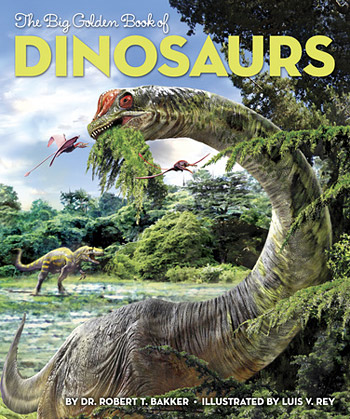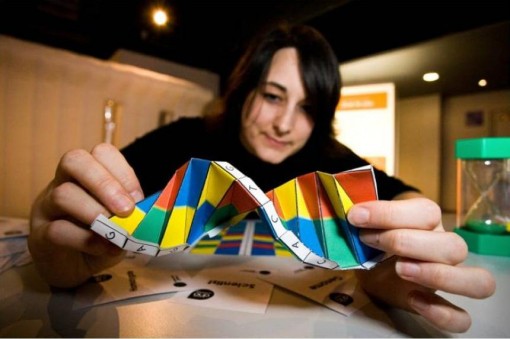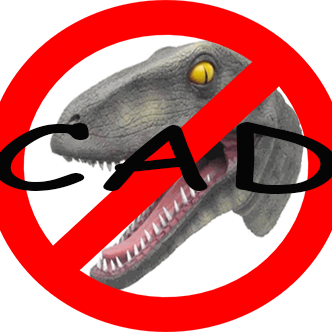 For the last week or so, a site for a group calling itself “Christians Against Dinosaurs” has gone viral, and at least a dozen of my Facebook friends have forwarded it to me in surprise, curious as to whether I’d seen it and if it is real. It managed to get covered in the Huffington Post, in Guff.com, and in several other online media outlets, giving it even more exposure. The site claims that dinosaurs (and fossils in general) are a lie to undermine our Christian faith, and that fossils seen in museums are faked or sculpted out of rock by “Big Paleo” trying to make millions by fraud. Prominently featured on the site and on Facebook and YouTube are short videos by a young woman who makes these very claims, and argues that paleontologists fabricate fossils out of the rock to look like animals. Even more shocking and hilarious, she seems to think that such faked fossils are worth millions of dollars and keep “Big Paleo” afloat. (If only she knew how impoverished most paleontologists are, and how there is no money in paleontology!). As Guff.com described it:
For the last week or so, a site for a group calling itself “Christians Against Dinosaurs” has gone viral, and at least a dozen of my Facebook friends have forwarded it to me in surprise, curious as to whether I’d seen it and if it is real. It managed to get covered in the Huffington Post, in Guff.com, and in several other online media outlets, giving it even more exposure. The site claims that dinosaurs (and fossils in general) are a lie to undermine our Christian faith, and that fossils seen in museums are faked or sculpted out of rock by “Big Paleo” trying to make millions by fraud. Prominently featured on the site and on Facebook and YouTube are short videos by a young woman who makes these very claims, and argues that paleontologists fabricate fossils out of the rock to look like animals. Even more shocking and hilarious, she seems to think that such faked fossils are worth millions of dollars and keep “Big Paleo” afloat. (If only she knew how impoverished most paleontologists are, and how there is no money in paleontology!). As Guff.com described it:
“A fossil is not actually a piece of bone,” she says in the video. “It’s actually a bone that was once in the ground that has been filled with limestone, calcium, and other stone-like deposits, so at the end of the day, it’s a rock made out of rocks. So, you have a rock that’s [six-inches long] and you hand it to a paleontologist, who chips away at it until you have something looking like a bone — and that is a fossil,” she continues. After covering a table with broken pieces of…something, she tells viewers to pretend they are paleontologists (ooh, activity time!) and put the shards back together in their original form. She even offered some spackle to assist in the reconstruction. But, she says, it’s supposed to be a brachiosaurus skull — and “If you’re a paleontologist and you want to keep your job, you turn that into a brachiosaurus skull.”
CONTINUE READING THIS POST…
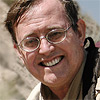
Dr. Donald Prothero taught college geology and paleontology for 35 years, at Caltech, Columbia, and Occidental, Knox, Vassar, Glendale, Mt. San Antonio, and Pierce Colleges. He earned his B.A. in geology and biology (highest honors, Phi Beta Kappa, College Award) from University of California Riverside in 1976, and his M.A. (1978), M.Phil. (1979), and Ph.D. (1982) in geological sciences from Columbia University. He is the author of over 35 books. Read Donald’s full bio or his other posts on this blog.
In my last post I outlined a small recent stir caused by sharp comments about skeptics from former Ghost Hunters cast member Amy Bruni. I promised to dig further into the issues of skeptical undercover work and “sting”-type traps designed either to expose the roots of claims or, in the most striking cases, to catch charlatans red-handed.
These tactics can be extremely hard hitting, when they hit their mark. A well-known case involving both deceptive undercover work and a shocking reveal is “Project Alpha,” organized by James Randi. Under his direction, teenaged magicians Steve “Banachek” Shaw and Michael Edwards posed as psychics in a laboratory setting, where they successfully bamboozled parapsychological researchers. When the skeptical conspirators eventually held a press conference and revealed their years of deception (video), the world was compelled to consider parapsychology’s vulnerability to fraud. The ripples from that hoax are still being felt, as Randi’s contemporary Ray Hyman predicted more than 30 years ago: “There’s going to be an argument from now until doomsday about what the whole thing showed.” Another classic example of a skeptical sting is the operation which severely set back the profitable faith healing career of Peter Popoff in 1986 (also spearheaded by Randi, in collaboration with the Houston Society to Oppose Pseudoscience, the Society of American Magicians, and the Bay Area Skeptics). The televised exposure of Popoff’s secret use of “miraculous” information relayed by radio surely stands one of the greatest “gotcha” moments of all time (video).
CONTINUE READING THIS POST…
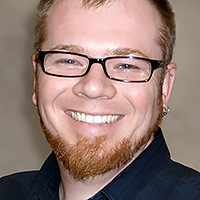
Daniel Loxton is the Editor of INSIGHT at Skeptic.com and of Junior Skeptic, the 10-page kids’ science section bound within Skeptic magazine. Daniel has been an avid follower of the paranormal literature since childhood, and of the skeptical literature since his youth. He is also an award-winning author. Read Daniel’s full bio or his other posts on this blog.
Few skeptical tactics are as hard-hitting or as ethically fraught as undercover investigation and “sting”-type traps designed to expose the roots of too-good-to-be-true claims—or even to catch tricksters red-handed. A recurring controversy over those tactics has flared up again over the last few days, following some sharp remarks about skeptics from former Ghost Hunters cast member Amy Bruni. Bruni took to her Facebook Page to express her frustration with skeptics who engage in such tactics, presumably in reaction to two recent sting attempts (dubbed “Operation Bumblebee” and “Operation Ice Cream Cone” by organizer Susan Gerbic). Bruni wrote:
Weird…I don’t see people who believe in paranormal and psychic phenomena accosting “skeptics” at their conventions and gatherings—or posting constant blogs and forums about how skepticism is terrible. Strangely enough, we really don’t care what their belief system is—because it is their right. And personally, I don’t care or have to justify what I believe to someone else.
So, why do they feel the need to constantly bash what we do? Arrange “guerrilla stings” on psychics and paranormal conventions? I mean—puh-lease, you must have something better to do.
Truly—there’s a whole lot of bad in this world. And if your “cause” is to take on people whose thoughts on life and existence are different from yours, (but causing YOU no harm), I think it’s time you take a little look at yourself.
Make a real difference with the time you have. Volunteer at an animal shelter, join Big Brothers/Big Sisters, serve food at your local soup kitchen…the list goes on.
Because I have news for you—none of us kooky paranormal folks need saving.
CONTINUE READING THIS POST…

Daniel Loxton is the Editor of INSIGHT at Skeptic.com and of Junior Skeptic, the 10-page kids’ science section bound within Skeptic magazine. Daniel has been an avid follower of the paranormal literature since childhood, and of the skeptical literature since his youth. He is also an award-winning author. Read Daniel’s full bio or his other posts on this blog.
As we celebrate the 206th anniversary of the birth of Charles Darwin today (Feb. 12), there is both good news and bad news in the continuing culture war over evolution. First, the good news. In a number of places, our political representatives have placed motions on the floor of Congress and several state legislatures to recognize February 12 as Darwin Day. Given the aversion to even the mention of evolution by most politicians today (even those who accept it, but don’t want to alienate creationists), this is very encouraging sign. But of course, this bit of good news is countered by the fact that creationist bills keep cropping up all the year round (see the NSCE website for a litany of recent rashes of creationist attacks). In the school districts of Louisiana, Tennessee, and several other states, there are backdoor ways to introduce creationism into public school science classes, or at least to cast doubt on evolution. This problem never seems to end, although there are good signs in the current polls that the younger generation (especially the millennials) are becoming more and more secular, and reject religious fundamentalism and creationism. Over the long term, that is very good news, because the creationists are no longer growing in numbers, but losing the next few generations and may be doomed to becoming a tiny minority with limited political influence in another generation.
CONTINUE READING THIS POST…

Dr. Donald Prothero taught college geology and paleontology for 35 years, at Caltech, Columbia, and Occidental, Knox, Vassar, Glendale, Mt. San Antonio, and Pierce Colleges. He earned his B.A. in geology and biology (highest honors, Phi Beta Kappa, College Award) from University of California Riverside in 1976, and his M.A. (1978), M.Phil. (1979), and Ph.D. (1982) in geological sciences from Columbia University. He is the author of over 35 books. Read Donald’s full bio or his other posts on this blog.

A modern newsroom in Berlin. By Thomas Schmidt (NetAction) via Wikimedia Commons.
I’ve long advocated the construction of customized online tools (websites, apps and more) to advance the cause of skepticism. In the last two years I’ve noticed a distinct trend where these tools are in being built in increasing numbers—but not just by skeptics! One major source of these tools might surprise you: the newspaper industry.
CONTINUE READING THIS POST…

Tim Farley is a computer security analyst in Atlanta, Georgia as well as a writer, podcaster and lecturer. He is known for his website What’s the Harm?, which catalogs the real-world consequences of irrational beliefs. He also writes on technology issues for skeptics at his Skeptical Software Tools blog, where he advocates for skeptic online best practices and explores crowdsourcing as a skeptical technique. Read Tim’s full bio or his other posts on this blog.
GUEST POST
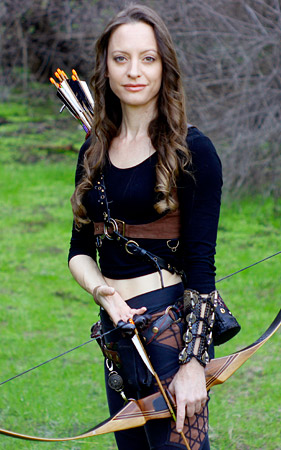
Anna Maltese. (Image courtesy of the author.)
In the past two weeks you’ve probably seen a viral archery video circulated on social media which makes a lot of claims about modern and historical archery. Since its posting on January 23, it has been viewed over 25 million times.
Dubbing himself “the fastest archer on the planet,” Lars Andersen, a visual artist and archer who specializes in speed trick shooting, sets about making claims about modern and historical archery and then demonstrating shooting techniques based on those claims. It’s not his techniques which have gotten him in hot water, though, so much as his claims about those techniques.
So first off, let’s be clear about what he’s doing here: Lars is performing what’s called “trick shooting.” Trick shooting isn’t a derogatory term. It’s not meant to imply that something is “faked” (although there are aspects to the video that veer into outright misrepresentations which we’ll get into later in our video response, below). Trick shooting is basically stunt shooting—like everything else, it takes practice, and the methods and stunts vary nearly as widely as the individual practitioners. And with his speed and antics, Lars has the potential to be an entertaining as well as very fast trick shooter.
CONTINUE READING THIS POST…

Anna Maltese is an archery instructor who builds bows, competes in tournaments, and performs fire archery. She is also an artist who spent most of her adult life animating for the Simpsons before becoming a freelance illustrator and digital painter.

(Image by Ani Aharonian with Daniel Loxton.)
A popular YouTube channel called
Numberphile has published
a video in which they claim to have a good strategy for winning at Rock, Paper, Scissors, gleaned from
a paper on the topic. The video was only posted on January 27th, but it has already been viewed well over a half million times and is popping up in blog posts at popular sites. It’s got some cute animation and the material is presented by a charming mathematician named
Hannah Fry who is clearly no dummy.
But several statements she made bothered me and I found the whole thing a confusing jumble when it came to presenting the findings of the paper, so I read the paper myself, did some additional research, and found what I think are some nontrivial problems with the way the paper has been interpreted. The paper was published online nearly a year ago and has been covered on dozens of academic review, popular news, and other websites, at least one of which is likely the source of what Fry presents. Reports range in quality from getting the research completely wrong to a rather good explanation with a ridiculously wrong title.
Nearly every report of this paper got the most crucial detail wrong.
CONTINUE READING THIS POST…

Barbara Drescher taught quantitative and cognitive psychology, primarily at California State University, Northridge for a decade. Barbara was a National Science Foundation Fellow and a Phi Kappa Phi Scholar. Her research has been recognized with several awards and the findings discussed in Psychology Today. More recently, Barbara developed educational materials for the James Randi Educational Foundation. Read Barbara’s full bio or her other posts on this blog.
 About a month ago, my phone suggested that I might want to read a Newsweek article called “The Campaign to Prove Shakespeare Didn’t Exist” by Robert Gore-Langton. I was somewhat disturbed that my phone knew I had an interest in the manufactured controversy over Shakespeare’s authorship of the works attributed to him. I was also a little irritated that my phone, which has apparently progressed from snooping through my email to acquiring some form of telepathy, didn’t know that I was getting tired of the subject.
About a month ago, my phone suggested that I might want to read a Newsweek article called “The Campaign to Prove Shakespeare Didn’t Exist” by Robert Gore-Langton. I was somewhat disturbed that my phone knew I had an interest in the manufactured controversy over Shakespeare’s authorship of the works attributed to him. I was also a little irritated that my phone, which has apparently progressed from snooping through my email to acquiring some form of telepathy, didn’t know that I was getting tired of the subject.
I’ve written about Shakespeare denialism many times before (most comprehensively here), and I’ve started to feel like I’m running around in circles while simultaneously banging my head against a wall (do not try this). The Newsweek headline, though, seemed to offer a new twist: Shakespeare didn’t exist at all?! Wow, that’s taking Shakespeare denialism as far as humanly possible. It’s as if someone not only claimed that the moon landing was a hoax but also said that there is no moon to land on. (Wait, what? Someone actually claimed that?)
Well, it turns out that Newsweek and my phone had tricked me with that headline. No one is saying that William Shakespeare, whose baptism and burial are recorded, didn’t exist. Instead someone is saying yet again that he was not the primary author of the plays and poems attributed to him.
CONTINUE READING THIS POST…

Eve Siebert contributes to the Skepticality podcast and is a panelist on the Virtual Skeptics webcast. She taught college writing and literature for many years. She has a Ph.D. in English literature from Saint Louis University. Her primary area of study is Old and Middle English literature, with secondary concentrations in Old Norse and Shakespeare. Read Eve’s full bio or her other posts on this blog.
This is Blake’s first post exploring the “Goddard’s Squadron Ghost” photo.
Read his second post on this topic, “New Facts Concerning Goddard Squadron Photo” (published July 31, 2015).
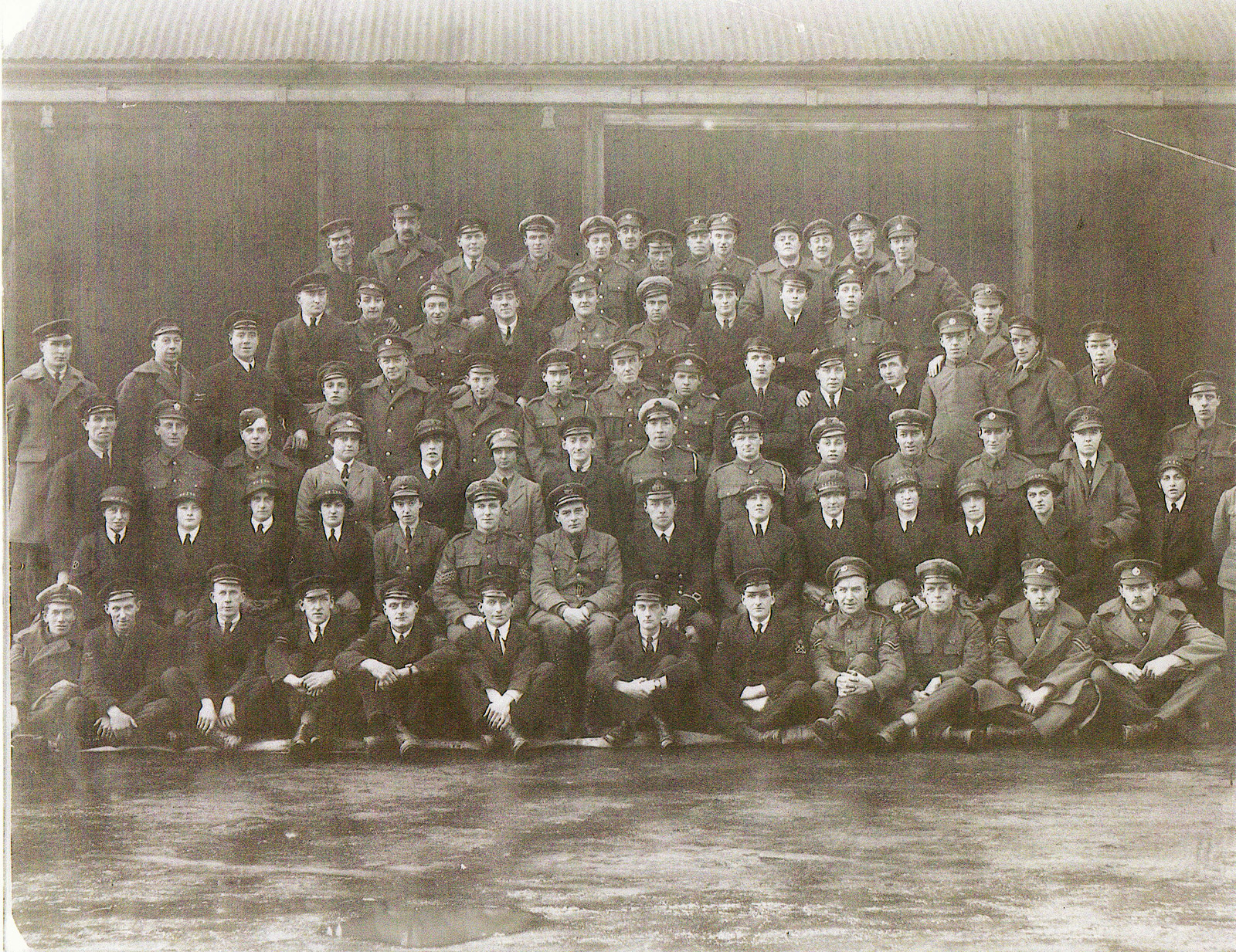
CLICK TO ENLARGE. Scanned copy of Bobbie Capel’s squadron photo allegedly including the ghost of Freddy Jackson.
I love looking at “ghost photos.” They’ve fascinated me all my life, but at some point I realized they didn’t all have to remain mysteries. The Watertown ghost photo and the Wem Town Hall ghost photo are now known to be hoaxes, for example. But some still call out for research.
One of the famous photos still promoted as a legitimate piece of photographic evidence for ghosts is that now known as the ghost of Goddard’s Squadron, allegedly the spirit of a dead chap named Freddy Jackson. It dates from the end of World War I and shows a group of military personnel standing for a squadron portrait. But according to the tale behind this image there is one extra person in the photo—and he’d been dead for a few days.
CONTINUE READING THIS POST…
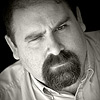
Blake Smith is the producer and host of MonsterTalk, an official podcast of Skeptic magazine. He’s had a lifelong interest in science and the paranormal and enjoys researching the strange and unusual. By day he’s a computer consultant and by night he hunts monsters. He is married and has children. Puns are intentional; don’t bother alerting the management. Read Blake’s other posts on this blog.

Baby Maggie Simpson and Mrs. Krabappel doing science. (Original art by former “Simpsons” animator Anna Maltese, used with permission).
Several times a week my email inbox contains offers to contribute to journals in subjects like engineering and agricultural sciences and in many other fields. The emails look legit, but my red flags go up nonetheless. I’m not an engineer, nor do I work in agriculture, or most other fields. I’m a geologist and paleontologist, and I teach geophysics, astronomy, oceanography, and meteorology, but I don’t work in every field of science. Clearly, my email address (which I willingly gave to legitimate scientific organizations) has been added to a compilation of scientists’ email addresses and sold and now every scam “journal” will spam me with these emails, not worrying about whether their “journal” is in my field or not.
CONTINUE READING THIS POST…

Dr. Donald Prothero taught college geology and paleontology for 35 years, at Caltech, Columbia, and Occidental, Knox, Vassar, Glendale, Mt. San Antonio, and Pierce Colleges. He earned his B.A. in geology and biology (highest honors, Phi Beta Kappa, College Award) from University of California Riverside in 1976, and his M.A. (1978), M.Phil. (1979), and Ph.D. (1982) in geological sciences from Columbia University. He is the author of over 35 books. Read Donald’s full bio or his other posts on this blog.
The Big Golden Book of Dinosaurs, by Robert T. Bakker, illustrated by Luis V. Rey (New York: Golden Books, 2013); 64 pages; reviewed by Daniel Loxton.
This review also appears in the current January–February 2015 issue of the Reports of the National Center for Science Education (Vol. 35, No. 1). See the table of contents, or download a PDF copy of this article here.
I’ve always loved books about prehistoric animals. Nothing brings back the glow and wonder of childhood like opening my dog-eared, loose-paged copies of Golden Books’ 1977 Dinosaurs, with its old-school tail-dragging creatures painted by legendary fantasy artists Tim and Greg Hildebrandt, or Happytime Books’ 1979 Dinosaurs, lovingly illustrated by Bernard Herbert Robinson—and lovingly inscribed “This book belongs to Danny” on the frontispiece. I spent more happy hours with those books than I could possibly tell you, curled up on my grandma’s couch. Did it matter that the animals were often inaccurate even by the standards of the time, or sometimes mislabeled altogether? Did I love such books less for presenting the whole of the geologic past as a jumbled Lost World where Jurassic Stegosaurus might have challenged Cretaceous T. rex, or perhaps even have grazed beside mammoths? Of course not—but with better books I might have loved these vanished creatures in deeper, truer ways.
CONTINUE READING THIS POST…

Daniel Loxton is the Editor of INSIGHT at Skeptic.com and of Junior Skeptic, the 10-page kids’ science section bound within Skeptic magazine. Daniel has been an avid follower of the paranormal literature since childhood, and of the skeptical literature since his youth. He is also an award-winning author. Read Daniel’s full bio or his other posts on this blog.
Jan. 23, 2015 by
Daniel Loxton |
Comments Off on Skeptic David Morrison Receives AAS Education Prize
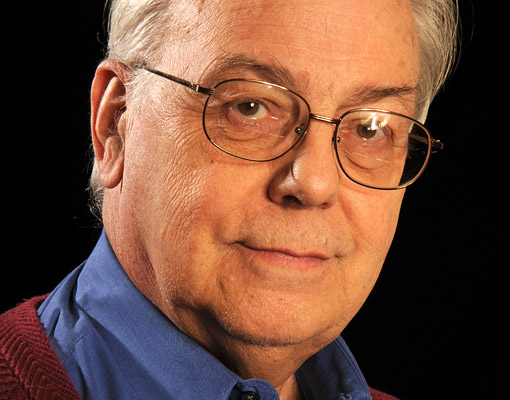
David Morrison. Image courtesy NASA Ames Research Center
Many congratulations are due to astronomer and skeptic David Morrison, named as the recipient of the 2015 Education Prize from the American Astronomical Society (AAS) at their 225th semiannual meeting held January 4–8, 2015 in Seattle, Washington. The AAS is North America’s major organization of professional astronomers.
CONTINUE READING THIS POST…

Daniel Loxton is the Editor of INSIGHT at Skeptic.com and of Junior Skeptic, the 10-page kids’ science section bound within Skeptic magazine. Daniel has been an avid follower of the paranormal literature since childhood, and of the skeptical literature since his youth. He is also an award-winning author. Read Daniel’s full bio or his other posts on this blog.

Aerial view of the La Conchita landslide after the 2005 event. (Photograph by Mark Reid, courtesy of the U.S. Geological Survey.)
Civilization exists by geological consent, subject to change without notice.
— Will Durant
The mountain is coming down!” he shrieked. Standing directly underneath the tumbling hillside, hearing its terrible crackle and roar and watching a plume of earth spew toward the sky, the men broke and ran for their lives … He lost sight of the others as the hillside bore down. Out of the corner of one eye, he could see a house and a trailer in hot pursuit.
— Los Angeles Times, January 2005
Ten years ago today, the tiny coastal town of La Conchita, California, experienced a terrible tragedy. The winter of 2004–2005 was unusually wet in Southern California. Many places in the steep mountains behind the urban belt had flooded and experienced landslides. Huge amounts of rain had fallen in the last weeks of December and the first weeks of January. In the sleepy coastal town of La Conchita, there was no reason to think that the winter rainy season would be unlike any other. La Conchita consisted of a few dozen houses with about 300 residents, located right on the coast on Highway 101 between the wealthier communities of Santa Barbara and Ventura. La Conchita was much more laid-back and inexpensive, with small beach cottages inhabited mostly by retired surfers, artists, beachcombers, and hippies who savored their pleasant beachfront life without Santa Barbara’s high prices and congestion.
CONTINUE READING THIS POST…

Dr. Donald Prothero taught college geology and paleontology for 35 years, at Caltech, Columbia, and Occidental, Knox, Vassar, Glendale, Mt. San Antonio, and Pierce Colleges. He earned his B.A. in geology and biology (highest honors, Phi Beta Kappa, College Award) from University of California Riverside in 1976, and his M.A. (1978), M.Phil. (1979), and Ph.D. (1982) in geological sciences from Columbia University. He is the author of over 35 books. Read Donald’s full bio or his other posts on this blog.

American psychologist and skeptic Joseph Jastrow. Image courtesy US National Library of Medicine, via Wikimedia Commons.
When better than the final days of the year to reflect on lessons of the past? Today, I’d like to share a small selection of quotes, each written over a century ago, which seem to me to bring the skepticism of our time and that of previous generations into a thought-provoking resonance. These passages employ concepts and jargon that are frequently used by skeptics today. This may strike us as prescient; however, I would argue that this apparent prescience is largely an illusory artifact of our own forgetfulness. In any event, these are a tiny sampling of conversations which were current in skepticism long before any of us were born.
I invite you to gaze into these passages, and reflect for a moment that in some ways the conceptual tools for skeptical examination of paranormal claims have changed little more in a century than the nature of imposture and superstition.
CONTINUE READING THIS POST…

Daniel Loxton is the Editor of INSIGHT at Skeptic.com and of Junior Skeptic, the 10-page kids’ science section bound within Skeptic magazine. Daniel has been an avid follower of the paranormal literature since childhood, and of the skeptical literature since his youth. He is also an award-winning author. Read Daniel’s full bio or his other posts on this blog.

Digital image showing cross section of the Java or Sunda trench, and the wave heights of the tsunami (gray peaks near the shoreline). (Courtesy USGS).
Today, December 26, 2014, is a somber anniversary. Ten years ago today, during the Christmas holidays, the southern regions of Thailand and the north coast of Sumatra was heavily populated, and also crowded with tourists seeking relief from Northern Hemisphere winters by enjoying the sun and pristine beaches. It was the day after Christmas (Boxing Day in the British calendar) when a violent earthquake struck 160 km (100 miles) off the northwest coast of Sumatra. It had a moment magnitude of 9.2, the second largest earthquakes ever recorded on a seismograph, and lasted between 8 and 10 minutes, the longest duration of shaking ever observed. The entire region vibrated by as much as 1 cm (0.5 inches), and triggered sympathetic earthquakes as far as Alaska. As the Indian plate is pushed under the Burma plate, it produces a huge subduction zone that is responsible for the island nations of Indonesia and Malaysia. The fault line of this plate boundary formed a rupture about 400 km (250 mi) long and 100 km (60 mi) wide, which was located 30 km (19 mi) beneath the seabed—the longest rupture ever caused by an earthquake. The energy released by the quake was about 550 million times more powerful than the A-bomb that wiped out Hiroshima. CONTINUE READING THIS POST…

Dr. Donald Prothero taught college geology and paleontology for 35 years, at Caltech, Columbia, and Occidental, Knox, Vassar, Glendale, Mt. San Antonio, and Pierce Colleges. He earned his B.A. in geology and biology (highest honors, Phi Beta Kappa, College Award) from University of California Riverside in 1976, and his M.A. (1978), M.Phil. (1979), and Ph.D. (1982) in geological sciences from Columbia University. He is the author of over 35 books. Read Donald’s full bio or his other posts on this blog.
The end of the year is a time for looking back, and that includes remembering who we have lost. For the last few years I’ve tried to do this for the skeptical community via blog posts and my segment on the Skepticality podcast. I also produce a visual presentation that is seen each year at The Amazing Meeting (TAM) in Las Vegas—this year’s was designed by Cheryl Hebert and INSIGHT blog editor Daniel Loxton.
Whenever I compile these lists, I try to include not only famous skeptics but also rank and file skeptics who have made contributions. I also attempt to include pseudoscientists and paranormalists of note, as well as others who have played a role in important incidents relevant to skepticism. Here are a few of the most notable, followed by a list of all the names I was able to find. (Please point out any omissions in the comments).
CONTINUE READING THIS POST…

Tim Farley is a computer security analyst in Atlanta, Georgia as well as a writer, podcaster and lecturer. He is known for his website What’s the Harm?, which catalogs the real-world consequences of irrational beliefs. He also writes on technology issues for skeptics at his Skeptical Software Tools blog, where he advocates for skeptic online best practices and explores crowdsourcing as a skeptical technique. Read Tim’s full bio or his other posts on this blog.
Looking at how students study, it is obvious that people approach learning in different ways. Some students like to read the textbook once through, some highlight and annotate the textbook extensively, some write and rewrite their notes, others record and play back lectures, others still make and review flashcards, and so on… But what do these differences in study strategies reflect? There are many possibilities. They may reflect variations in the way that people learn, or it may reflect differences in work ethic or learned habits. Researchers have mistakenly interpreted these differences in preference to reflect differences in the way that people learn and learning styles has become a popular and widespread pedagogical approach.
CONTINUE READING THIS POST…

Ani Aharonian is a cognitive psychologist and PhD student at the University of Nebraska, Lincoln, where she has focused on cognition and the intersection of law and psychology, specifically eyewitness identifications and testimony, memory, and learning. She currently works as an institutional researcher at Santa Monica College where she helps support and promote evidence-based approaches to planning and assessment. Read Ani’s full bio or her other posts on this blog.
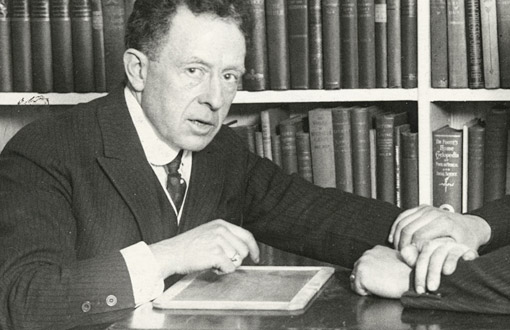
Skeptic Joseph Rinn, demonstrating mediumistic trickery for a press syndicate in 1920. (From Daniel Loxton’s collection.)
Scientific skepticism has a long history—roughly 40 years in its most modern organized form, and centuries (arguably millennia) as a more or less recognizable tradition. (See my “Why Is There a Skeptical Movement?” for a discussion of this lengthy intellectual thread—PDF.)
We’ve learned a lot in that time. Generations of skeptics have devoted themselves to understanding paranormal and pseudoscientific claims, beliefs, and impostures. But even with those efforts, the fringe has remained radically under-examinded. Because this realm is so vast while the scholars and activists interested in exploring it are so few, our work has often had something of a scrambling quality. In our rush, skeptics have tended to neglect, or at least to set aside for some future time, some of the improvements of better-established fields.
CONTINUE READING THIS POST…

Daniel Loxton is the Editor of INSIGHT at Skeptic.com and of Junior Skeptic, the 10-page kids’ science section bound within Skeptic magazine. Daniel has been an avid follower of the paranormal literature since childhood, and of the skeptical literature since his youth. He is also an award-winning author. Read Daniel’s full bio or his other posts on this blog.

Benedict Cumberbatch, left, portrays Alan Turing in The Imitation Game (Image: STUDIOCANAL); Eddie Redmayne, right, stars as Stephen Hawking in The Theory of Everything (Image: Liam Daniel / Focus Features)
A review of two new movies: the Stephen Hawking biography The Theory of Everything, and the Alan Turing biography The Imitation Game.
2014 has been a relatively good year for science in the public eye. At the beginning of the year, we had Bill Nye’s victory over creationist Ken Ham, and two outstanding TV series, Neil DeGrasse Tyson’s Cosmos, and Neil Shubin’s Your Inner Fish. In all three cases, leading American popularizers of science managed to get a lot of publicity for good science. They also were successful in striking blows against various forms of pseudoscience, which are still pervasive in the media (especially on basic cable channels like Discovery and TLC, which ran “fake-umentaries” this year about living gigantic sharks, living mermaids, killer yetis, and even a guy promising to let an anaconda swallow him—then reneging). Now the year is coming to an end with two outstanding biopics about two of the most brilliant British mathematicians and scientists of the mid-late twentieth century, cosmologist Stephen Hawking (The Theory of Everything), and mathematician/cryptanalyst/computer pioneer Alan Turing (The Imitation Game). In both cases, the movies are outstanding, not only in their acting, writing, directing, and cinematography, but especially their relatively accurate and sympathetic portrayal of science and scientists, with all its struggles and triumphs.
CONTINUE READING THIS POST…

Dr. Donald Prothero taught college geology and paleontology for 35 years, at Caltech, Columbia, and Occidental, Knox, Vassar, Glendale, Mt. San Antonio, and Pierce Colleges. He earned his B.A. in geology and biology (highest honors, Phi Beta Kappa, College Award) from University of California Riverside in 1976, and his M.A. (1978), M.Phil. (1979), and Ph.D. (1982) in geological sciences from Columbia University. He is the author of over 35 books. Read Donald’s full bio or his other posts on this blog.
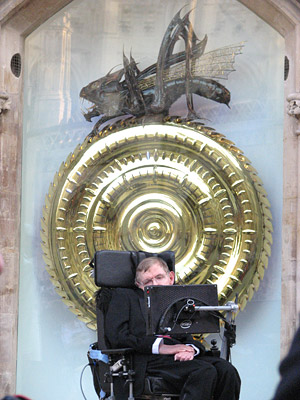
Stephen Hawking’s future: doomed singularity or invading aliens? Image by J. Nathan Matias, via Wikimedia Commons Commons. Used under Creative Commons Attribution-NonCommercial 2.0 Generic license.
Several years ago, eminent British cosmologist Professor Stephen Hawking made headlines by speculating that first contact with sentient aliens probably wouldn’t end in high-fives and tribble-cuddles. “If aliens visit us, the outcome would be much as when Columbus landed in America, which didn’t turn out well for the Native Americans,” he suggested.
As if that rosy idea wasn’t enough, Professor Hawking has now claimed the invention of artificial intelligence (AI) could precipitate the end of humanity. “It would take off on its own, and re-design itself at an ever increasing rate,” he recently told the BBC. “Humans, who are limited by slow biological evolution, couldn’t compete, and would be superseded.”
Intergalactic robots landing on his lawn must surely be nightmare-fuel.
It’s easy to dismiss the famous author’s pessimism as the harmless speculation of a respected intellectual (or, for those inclined, to accept his opinions with alarm). Yet given the challenges involved in engaging the public in the realities of science, the sci-fi musings of a world famous scientist might be less than helpful.
CONTINUE READING THIS POST…
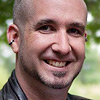
Mike McRae is an Australian science writer and teacher. He has worked for the CSIRO’s education group and developed resources for the Australian government, promoting critical thinking and science education through educational publications. His 2011 book Tribal Science: Brains, Beliefs and Bad Ideas explored humanity’s development to think scientifically—and pseudoscientifically—about the universe. Read Mike’s other posts on this blog.
← PREVIOUS
NEXT →
 For the last week or so, a site for a group calling itself “Christians Against Dinosaurs” has gone viral, and at least a dozen of my Facebook friends have forwarded it to me in surprise, curious as to whether I’d seen it and if it is real. It managed to get covered in the Huffington Post, in Guff.com, and in several other online media outlets, giving it even more exposure. The site claims that dinosaurs (and fossils in general) are a lie to undermine our Christian faith, and that fossils seen in museums are faked or sculpted out of rock by “Big Paleo” trying to make millions by fraud. Prominently featured on the site and on Facebook and YouTube are short videos by a young woman who makes these very claims, and argues that paleontologists fabricate fossils out of the rock to look like animals. Even more shocking and hilarious, she seems to think that such faked fossils are worth millions of dollars and keep “Big Paleo” afloat. (If only she knew how impoverished most paleontologists are, and how there is no money in paleontology!). As Guff.com described it:
For the last week or so, a site for a group calling itself “Christians Against Dinosaurs” has gone viral, and at least a dozen of my Facebook friends have forwarded it to me in surprise, curious as to whether I’d seen it and if it is real. It managed to get covered in the Huffington Post, in Guff.com, and in several other online media outlets, giving it even more exposure. The site claims that dinosaurs (and fossils in general) are a lie to undermine our Christian faith, and that fossils seen in museums are faked or sculpted out of rock by “Big Paleo” trying to make millions by fraud. Prominently featured on the site and on Facebook and YouTube are short videos by a young woman who makes these very claims, and argues that paleontologists fabricate fossils out of the rock to look like animals. Even more shocking and hilarious, she seems to think that such faked fossils are worth millions of dollars and keep “Big Paleo” afloat. (If only she knew how impoverished most paleontologists are, and how there is no money in paleontology!). As Guff.com described it:
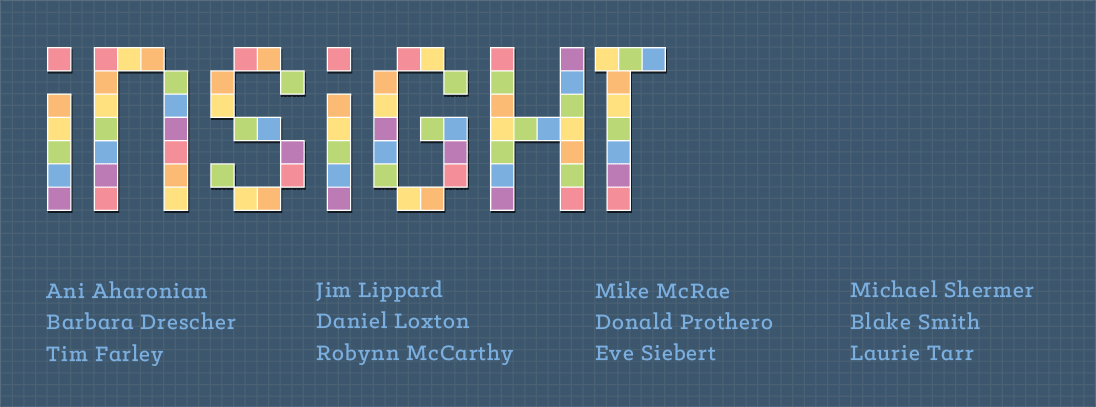


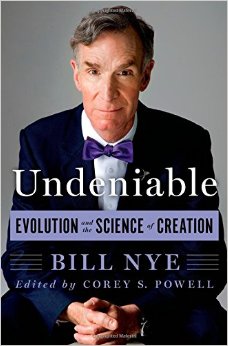






 About a month ago, my phone suggested that I might want to read a Newsweek article called “
About a month ago, my phone suggested that I might want to read a Newsweek article called “



